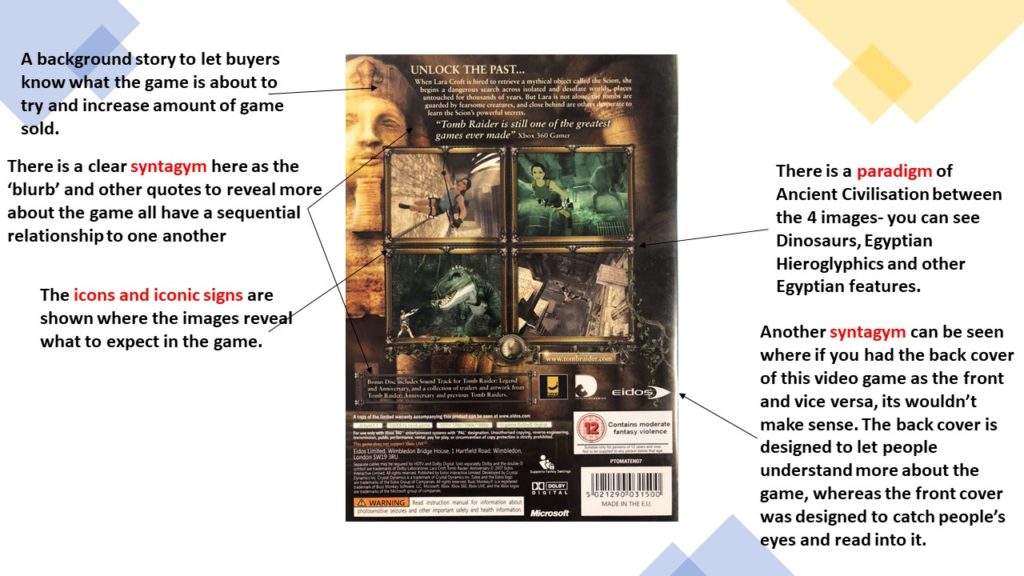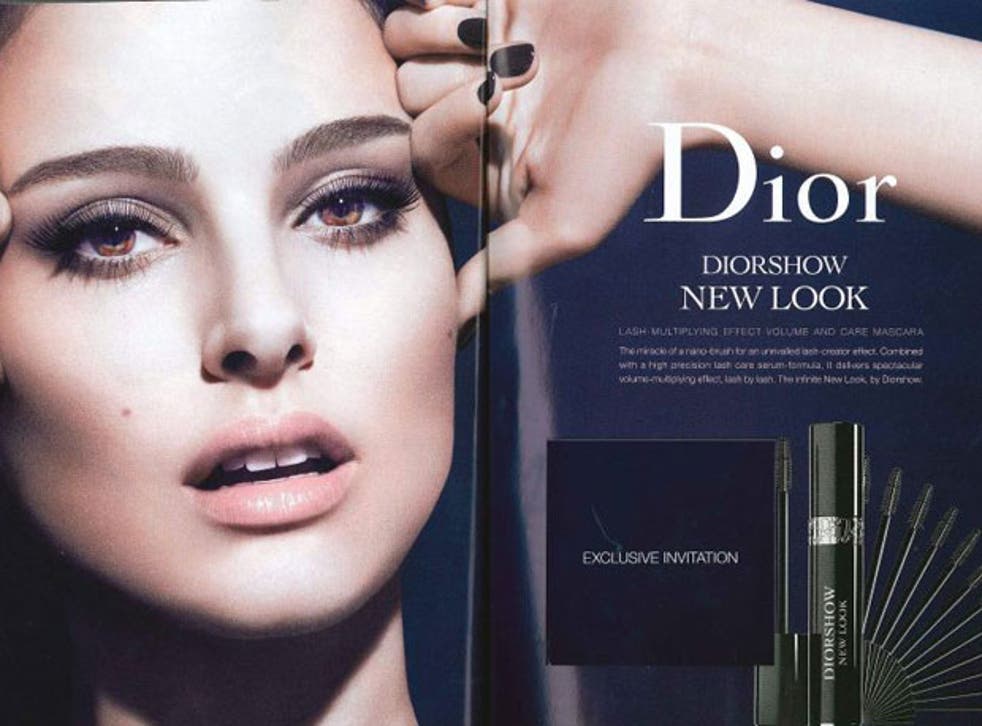All posts by Natasha Rawley
Filters
CSP Game cover essay
ANALYSE THE RELATIONSHIP BETWEEN SIGNIFIERS AND SIGNIFIEDS IN THE TWO CSP GAMES COVERS.
The relationship between signifiers and signified in the two CSP games covers can be seen and analysed in multiple different ways. For example, feminist film expert, Laura Mulvey invented the concept of women being looked at in a very sexualised way by males in order to make them feel important and better about themselves, objectifying them. This is called the ‘Male Gaze’. For example, in ‘Tomb Raider’ the main thought as you look at the front cover is immediately the stereotype of women in a ‘man’s eyes’ in video games. This can be supported by the iconic signs such as the props Lara Croft is holding/has on her person, which symbolises her being strong, appearing more attractive to males. Another part of this to mention is the way Lara Croft has been portrayed with exaggerated body parts in order for the males to enjoy the game more, which of course is seen as reactionary.
While Tomb Raider can be seen as a very negative representation of feminism and is reactionary for its audience, you could also argue that it is radical. For example, the very fact that it shows a woman having the ability to be strong, involved in action and have the practice in firearms, proves that women do not always have to be the ‘damsel in distress’ as several videos ‘Feminist Frequency’ have posted explaining. Most video games that include female characters usually have them kidnapped or something happen to them at the beginning of the story, so the main character (a male) can save them from the danger, subtly hinting that women cannot save themselves. The quote “This poor representation of Asian women perpetuates the stereotype that they are meek, submissive, sexual objects who exist purely for men’s entertainment” from the article ‘Levelling up Representation’ indicates in detail about not only women in general but women with specific ethnicities being sexualised and objectified for men’s entertainment.
Another way that further explains this is the concept of ‘Feminist, female, feminine’ introduced by Toril Moi, where the difference between the three is explained, and how there is ‘male’ and ‘manly’ but no equivalent for ‘feminist’. This instantly shows that males have always had a sense of authority and hierarchy over females, which can be seen in the game cover of Metroid. The cover presents a very strong, manly character in a suit that can be described as ‘only male characters wear’. At the very end of the game, the manly character reveals themselves to be female. This suggests how nobody knows until the end of the game, many people who play the game automatically assume it’s a male because of the appearance in the ’suit’ and that stereotypically, women don’t present themselves that way, once again showing that males have more authority over women. Once Samus (the character) reveals to be a female, it shows that you will never know what gender the character is. Would it decrease sales of the game if it was known from the start that Samus was a female? When she reveals herself, she is massively over sexualised wearing a tight blue suit and has her hair in a long ponytail. The juxtaposition between a very ‘manly’, strong character who ends up being, yet another over sexualised female is major and should not be allowed.
In summary, I believe that the two game covers are reactionary for its audience, both males. For Tomb Raider, the character is female and extremely over sexualised, allowing customers to purchase the game more as they are attracted to the front cover. For Metroid, the character is male and is perceived as strong, again allowing the customers to buy it more as the male audience like the fact the character is strong and manly. Both are seen as reactionary and radical in their own ways and I personally think that they should do better and think about how they are perceiving women and how damaging that is.
Games cOVER REDESIGN- RADICAL REPRESENTATION

- I
8 QUOTES
“A 2015 study showed that 83% of non-Hispanic Black teenagers play video games, compared to 71% of Caucasian teenagers, with 69% of Hispanic teens not too far behind. With the high percentage of teens of color playing games, representation is incredibly important but has — at least historically — been lacking.”- Levelling up representation
“This poor representation of Asian women perpetuates the stereotype that they are meek, submissive, sexual objects who exist purely for men’s entertainment.” -levelling up representation
“The industry traditionally projects an image that is young, white, straight and male, but there is growing understanding that – if only for the sake of releasing more interesting products – this has to change.” – why diversity matters
“The industry has been improving its depiction of non-white, non-male characters for several years, but in the last three E3 events, there has been a real sense of momentum, belief and priority – as if this isn’t just something to pay lip service to – it actually matters from a creative and commercial standpoint.” -why diversity matters
Key terms around representation
- Male gaze– A concept in which men objectify women
- Voyeurism– An interest in watching people engage is personal, sometimes sexual activities where they do not know
- Patriarchy– A society dominated by males
- Positive and negative stereotypes– When a group/person is boxed into a stereotype and either receives positive or negative feedback from it
- Countertypes– Representation in which the stereotype is opposite to the person
- Misrepresentation– Giving misleading information
- Selective representation– Only showing some/not all the events of something so you don’t know everything that happened
- Dominant ideology– Attitudes, beliefs, values, and morals shared by the majority of the people in a given society
- Constructed reality– The way in which something is represented that allows media to be seen as a reality
- Hegemony– global dominance and influence of powerful commercial mass media organizations
- Audience positioning– The relationship between the text producer and receiver and how they react and respond to a text
- Fluidity of identity– The ability to change how you identify yourself
- Constructed identity– Identifying yourself differently to others by things you go through and things you have interests in
- Negotiated identity– The idea in which you come to an agreement of ‘who is who’
- Collective identity– A shared identification between people and groups
cover essay
I have produced a games cover called ‘Snowboarder x-treme’, which revolves around playing against your friends to reach the end of the snowboard race. This was influenced by a Snowboard Video game I used to play as a kid. This is stereotypically a masculine game as it is a type of sport, and to make this more reactionary, I had a female character on the front, who I exaggerated her features to further accentuate the masculinity of the game. Toril Moi’s research on the distinction between female, feminine, feminist categories can be seen on my cover with the female character in a ‘sexualised’ outfit with exaggerated features.
game cover: snowboarder x-treme- Natasha

CSP 1&2 TOMB RAIDER AND METRIOD- NATASHA



REPRESENTATION, video game design- natasha rawley
Statement of Intent:
My intentions of what I would like to produce as a video game cover is to create a Snowboarder game with men and women. For the reactionary cover, I am going to have a women of the cover (maybe with a man too) and have her snowboarding outfit tighter than the usual snow outfit, while making the men’s outfit your stereotypical baggy outfit.
In the reactionary cover, I will use symbolic signs such as different colours (blue for the sky) to represent the setting of the video game. I will use indexical signs for example, maybe a snowboard as a prop to show the very obvious link to snowboarding. I will also have trees in the background and snow to make the game more believable.
REpresentation- natasha rawley
The Male Gaze and Laura Mulvey:
Feminist film expert, Laura Mulvey, invented the concept of women being looked at in a very sexualised way by males in order to make them feel important and better about themselves, objectifying them. This is called The Male Gaze- the way in which men look at women in a sexualising way.
John Berger:
John Berger was an English Art Critic who wrote the famous essay ‘Ways of Seeing’. This essay includes ideas of the different ways men and women are represented in visual media, and Laura Mulvey’s concept of The Male Gaze.
“Men look at women. Women watch themselves being looked at. This determines not only most relations between men and women but also the relation of women to themselves.” – Ways of Seeing



